You have 100 Microsoft SQL Server Integration Services (SSIS) packages that are configured to use 10 on-premises SQL Server databases as their destinations.
You plan to migrate the 10 on-premises databases to Azure SQL Database.
You need to recommend a solution to host the SSIS packages in Azure. The solution must ensure that the packages can target the SQL Database instances as their destinations.
What should you include in the recommendation?
Answer:
B
HOTSPOT -
You are planning an Azure Storage solution for sensitive data. The data will be accessed daily. The data set is less than 10 GB.
You need to recommend a storage solution that meets the following requirements:
✑ All the data written to storage must be retained for five years.
✑ Once the data is written, the data can only be read. Modifications and deletion must be prevented.
✑ After five years, the data can be deleted, but never modified.
✑ Data access charges must be minimized.
What should you recommend? To answer, select the appropriate options in the answer area.
NOTE: Each correct selection is worth one point.
Hot Area: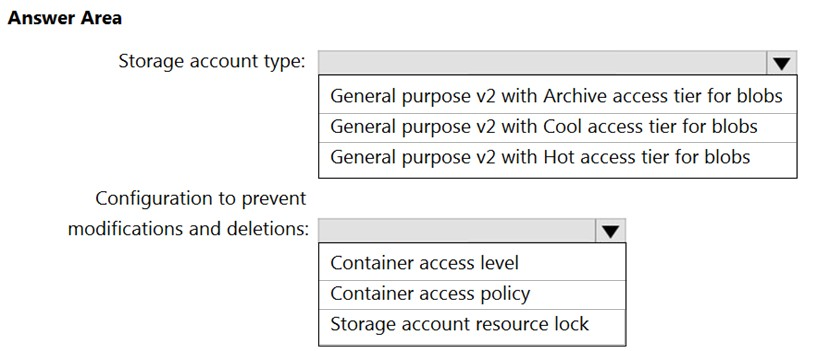
Answer:
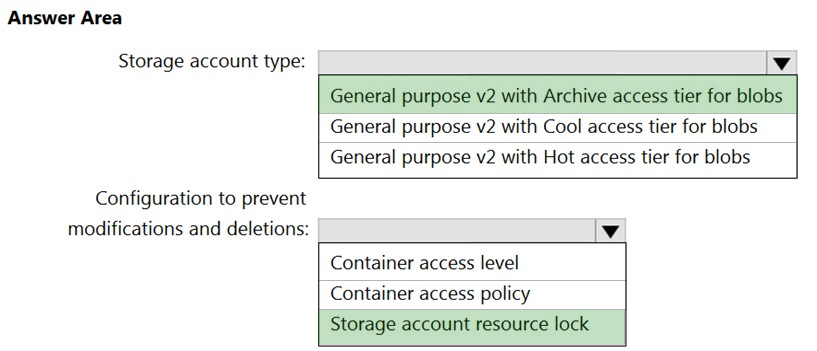
Box 1: General purpose v2 with Archive acce3ss tier for blobs
Archive - Optimized for storing data that is rarely accessed and stored for at least 180 days with flexible latency requirements, on the order of hours.
Cool - Optimized for storing data that is infrequently accessed and stored for at least 30 days.
Hot - Optimized for storing data that is accessed frequently.
Box 2: Storage account resource lock
As an administrator, you can lock a subscription, resource group, or resource to prevent other users in your organization from accidentally deleting or modifying critical resources. The lock overrides any permissions the user might have.
Note: You can set the lock level to CanNotDelete or ReadOnly. In the portal, the locks are called Delete and Read-only respectively.
✑ CanNotDelete means authorized users can still read and modify a resource, but they can't delete the resource.
✑ ReadOnly means authorized users can read a resource, but they can't delete or update the resource. Applying this lock is similar to restricting all authorized users to the permissions granted by the Reader role.
Reference:
https://docs.microsoft.com/en-us/azure/storage/blobs/storage-blob-storage-tiers
You have an Azure subscription. The subscription contains an app that is hosted in the East US, Central Europe, and East Asia regions.
You need to recommend a data-tier solution for the app. The solution must meet the following requirements:
✑ Support multiple consistency levels.
✑ Be able to store at least 1 TB of data.
✑ Be able to perform read and write operations in the Azure region that is local to the app instance.
What should you include in the recommendation?
Answer:
A
Azure Cosmos DB approaches data consistency as a spectrum of choices. This approach includes more options than the two extremes of strong and eventual consistency. You can choose from five well-defined levels on the consistency spectrum.
With Cosmos DB any write into any region must be replicated and committed to all configured regions within the account.
Incorrect Answers:
D: Not able to do local writes.
Reference:
https://docs.microsoft.com/en-us/azure/cosmos-db/consistency-levels-tradeoffs
You have an Azure subscription.
Your on-premises network contains a file server named Server1. Server1 stores 5 TB of company files that are accessed rarely.
You plan to copy the files to Azure Storage.
You need to implement a storage solution for the files that meets the following requirements:
✑ The files must be available within 24 hours of being requested.
✑ Storage costs must be minimized.
Which two possible storage solutions achieve this goal? Each correct answer presents a complete solution.
NOTE: Each correct selection is worth one point.
Answer:
CD
The Cool access tier is optimized for storing data that is infrequently accessed and stored for at least 30 days.
Using a file share is cheaper than using a blob container.
Incorrect Answers:
A: Using a file share would be cheaper than using a Blob container.
B, E: The Archive tier is optimized for storing data that is rarely accessed and stored for at least 180 days with flexible latency requirements (on the order of hours).
Reference:
https://docs.microsoft.com/en-us/azure/storage/blobs/storage-blob-storage-tiers
You use Azure Application Insights.
You plan to use continuous export.
You need to store Application Insights data for five years.
Which Azure service should you use?
Answer:
D
Create a Continuous Export.
1. In the Application Insights resource for your app under configure on the left, open Continuous Export and choose Add:
2. Choose the telemetry data types you want to export.
3. Create or select an Azure storage account where you want to store the data. Click Add, Export Destination, Storage account, and then either create a new store or choose an existing store.
4. Create or select a container in the storage.
Reference:
https://docs.microsoft.com/en-us/azure/azure-monitor/app/export-telemetry#continuous-export-advanced-storage-configuration
You have an Azure subscription that contains an Azure SQL database.
You are evaluating whether to use Azure reservations on the Azure SQL database.
Which tool should you use to estimate the potential savings?
Answer:
A
Buy reserved capacity -
1. Sign in to the Azure portal.
2. Select All services > Reservations.
3. Select Add and then in the Purchase Reservations pane, select SQL Database to purchase a new reservation for SQL Database.
4. Fill in the required fields. Existing databases in SQL Database and SQL Managed Instance that match the attributes you select qualify to get the reserved capacity discount. The actual number of databases or managed instances that get the discount depends on the scope and quantity selected.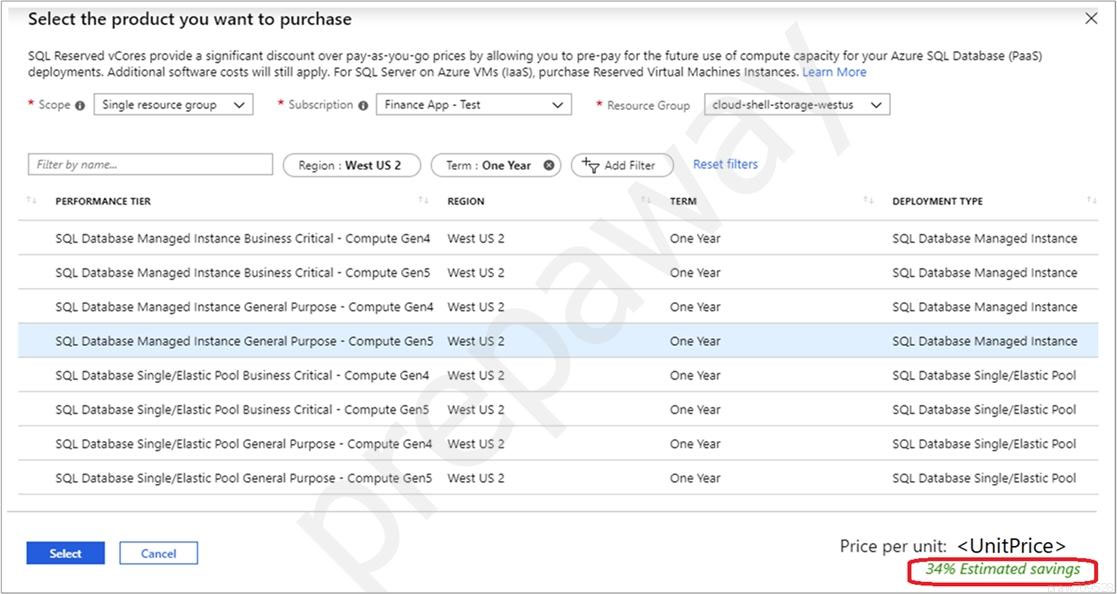
5. Review the cost of the capacity reservation in the Costs section.
6. Select Purchase.
7. Select View this Reservation to see the status of your purchase.
Reference:
https://docs.microsoft.com/en-us/azure/azure-sql/database/reserved-capacity-overview
HOTSPOT -
You have an Azure subscription that contains the storage accounts shown in the following table.
You plan to implement two new apps that have the requirements shown in the following table.
Which storage accounts should you recommend using for each app? To answer, select the appropriate options in the answer area.
NOTE: Each correct selection is worth one point.
Hot Area: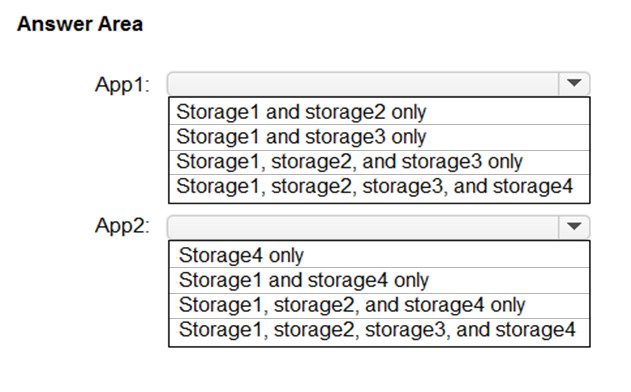
Answer:
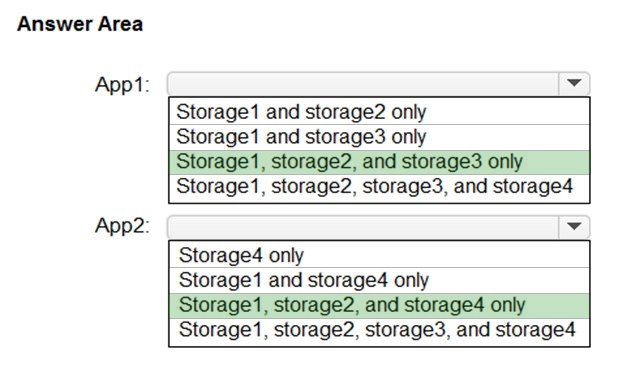
Box 1: Storage1, storage2, and storage3 only
Azure Blob Storage lifecycle management offers a rich, rule-based policy for GPv2 and blob storage accounts. Use the policy to transition your data to the appropriate access tiers or expire at the end of the data's lifecycle.
Box 2: Storage1, storage2, and storage4 only
General purpose version 2 (GPv2) storage accounts: GPv2 storage accounts allow you to deploy Azure file shares on standard/hard disk-based (HDD-based) hardware.
FileStorage storage accounts: FileStorage storage accounts allow you to deploy Azure file shares on premium/solid-state disk-based (SSD-based) hardware.
Reference:
https://docs.microsoft.com/en-us/azure/storage/blobs/storage-lifecycle-management-concepts
You have an Azure subscription that contains an Azure SQL database.
You plan to use Azure reservations on the Azure SQL database.
To which resource type will the reservation discount be applied?
Answer:
A
Quantity: The amount of compute resources being purchased within the capacity reservation. The quantity is a number of vCores in the selected Azure region and
Performance tier that are being reserved and will get the billing discount. For example, if you run or plan to run multiple databases with the total compute capacity of Gen5 16 vCores in the East US region, then you would specify the quantity as 16 to maximize the benefit for all the databases.
Reference:
https://docs.microsoft.com/en-us/azure/azure-sql/database/reserved-capacity-overview
You are designing an Azure Cosmos DB solution that will host multiple writable replicas in multiple Azure regions.
You need to recommend the strongest database consistency level for the design. The solution must meet the following requirements:
✑ Provide a latency-based Service Level Agreement (SLA) for writes.
✑ Support multiple regions.
Which consistency level should you recommend?
Answer:
A
Each level provides availability and performance tradeoffs. The following image shows the different consistency levels as a spectrum.
Note: The service offers comprehensive 99.99% SLAs which covers the guarantees for throughput, consistency, availability and latency for the Azure Cosmos DB
Database Accounts scoped to a single Azure region configured with any of the five Consistency Levels or Database Accounts spanning multiple Azure regions, configured with any of the four relaxed Consistency Levels.
Incorrect Answers:
B: Strong consistency for accounts with regions spanning more than 5000 miles (8000 kilometers) is blocked by default due to high write latency. To enable this capability please contact support.
Reference:
https://azure.microsoft.com/en-us/support/legal/sla/cosmos-db/v1_3/ https://docs.microsoft.com/en-us/azure/cosmos-db/consistency-levels#consistency-levels-and-latency
DRAG DROP -
Your company identifies the following business continuity and disaster recovery objectives for virtual machines that host sales, finance, and reporting applications in the company's on-premises data center:
✑ The sales application must be able to fail over to a second on-premises data center.
✑ The finance application requires that data be retained for seven years. In the event of a disaster, the application must be able to run from Azure. The recovery time objective (RTO) is 10 minutes.
✑ The reporting application must be able to recover point-in-time data at a daily granularity. The RTO is eight hours.
You need to recommend which Azure services meet the business continuity and disaster recovery objectives. The solution must minimize costs.
What should you recommend for each application? To answer, drag the appropriate services to the correct applications. Each service may be used once, more than once, or not at all. You may need to drag the split bar between panes or scroll to view content.
NOTE: Each correct selection is worth one point.
Select and Place: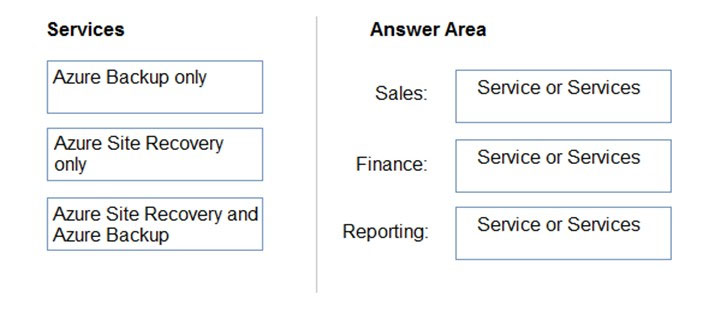
Answer:
